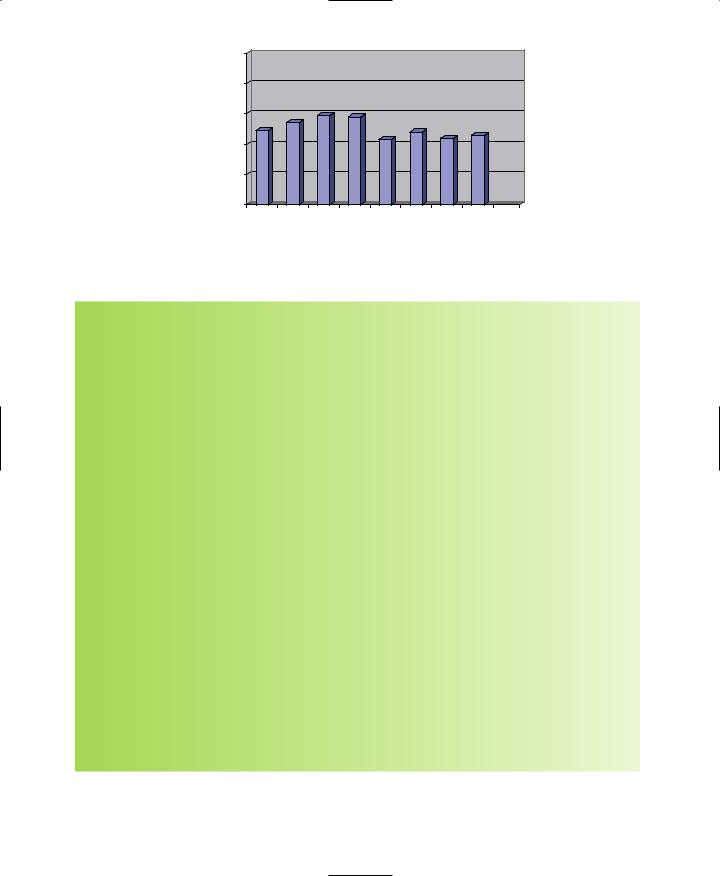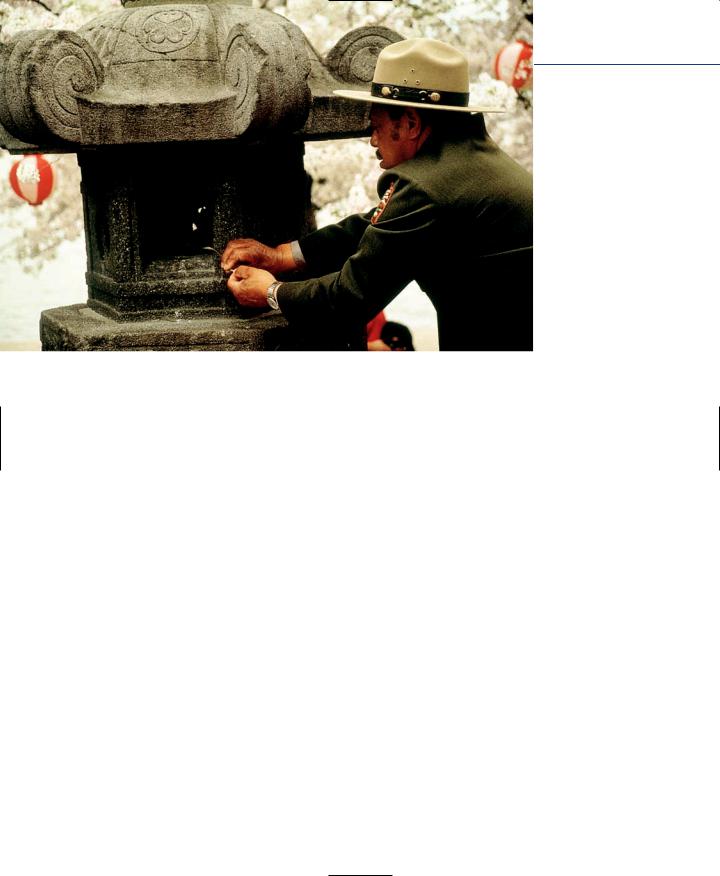
- •CONTENTS
- •PREFACE
- •Content—Benefits for Students
- •Content—Benefits for Instructors
- •Features of the Book for Students and Instructors
- •Supplementary Materials
- •Acknowledgments
- •What Is Hospitality Management?
- •The Manager’s Role in the Hospitality Industry
- •Why Study in a Hospitality Management Program?
- •Planning a Career
- •Employment as an Important Part of Your Education
- •Getting a Job
- •Employment at Graduation
- •The Outlook for Hospitality
- •Summary
- •Managing Change
- •Demand
- •Supply
- •Workforce Diversity
- •The Impact of Labor Scarcity
- •Summary
- •The Varied Field of Food Service
- •The Restaurant Business
- •The Dining Market and the Eating Market
- •Contemporary Popular-Priced Restaurants
- •Restaurants as Part of a Larger Business
- •Summary
- •Restaurant Operations
- •Making a Profit in Food Service Operations
- •Life in the Restaurant Business
- •Summary
- •Chain Restaurant Systems
- •Independent Restaurants
- •Franchised Restaurants
- •Summary
- •Competitive Conditions in Food Service
- •The Marketing Mix
- •Competition with Other Industries
- •Summary
- •Self-Operated Facilities
- •Managed-Services Companies
- •Business and Industry Food Service
- •College and University Food Service
- •Health Care Food Service
- •School and Community Food Service
- •Other Segments
- •Vending
- •Summary
- •Consumer Concerns
- •Food Service and the Environment
- •Technology
- •Summary
- •The Evolution of Lodging
- •Classifications of Hotel Properties
- •Types of Travelers
- •Anticipating Guest Needs in Providing Hospitality Service
- •Service, Service, Service
- •Summary
- •Major Functional Departments
- •The Rooms Side of the House
- •Hotel Food and Beverage Operations
- •Staff and Support Departments
- •Income and Expense Patterns and Control
- •Entry Ports and Careers
- •Summary
- •The Economics of the Hotel Business
- •Dimensions of the Hotel Investment Decision
- •Summary
- •The Conditions of Competition
- •The Marketing Mix in Lodging
- •Product in a Segmented Market
- •Price and Pricing Tactics
- •Place—and Places
- •Promotion: Marketing Communication
- •Summary
- •The Importance of Tourism
- •Travel Trends
- •The Economic Significance of Tourism
- •The United States as an International Tourist Attraction
- •Businesses Serving the Traveler
- •Noneconomic Effects of Tourism
- •Summary
- •Motives and Destinations
- •Mass-Market Tourism
- •Planned Play Environments
- •Casinos and Gaming
- •Urban Entertainment Centers
- •Temporary Attractions: Fairs and Festivals
- •Natural Environments
- •On a Lighter Note. . .
- •Summary
- •Management and Supervision
- •The Economizing Society
- •The Managerial Revolution
- •Management: A Dynamic Force in a Changing Industry
- •What Is Management?
- •Summary
- •Why Study Planning?
- •Planning in Organizations
- •Goal Setting
- •Planning in Operations
- •The Individual Worker as Planner
- •Long-Range Planning Tools
- •Summary
- •Authority: The Cement of Organizations
- •Departmentalization
- •Line and Staff
- •Issues in Organizing
- •Summary
- •Issues in Human-Resources Management
- •Fitting People to Jobs
- •Recruiting
- •Selection and Employment
- •Training
- •Retaining Employees
- •Staff Planning
- •Summary
- •The Importance of Control
- •Control and the “Cybernetic Loop”
- •Tools for Control
- •Summary
- •Leadership as Viewed by Social Scientists
- •Why People Follow
- •Leadership Theories
- •Communication
- •The Elements of Leading and Directing
- •Developing Your Own Leadership Style
- •Summary
- •A Study of Service
- •Rendering Personal Service
- •Managing the Service Transaction
- •How Companies Organize for Service
- •Summary
- •INDEX

The mode of travel has changed a great deal just over the last 100 years. (Courtesy of National Park Service.)
Weekend vacations and shorter trips combining pleasure and business are more prevalent among younger travelers. Affluent travelers, with an average age of 50 or over, on the other hand, prefer vacations of a week or more.
The Economic Significance of Tourism
In total business receipts, tourism has consistently ranked second or third among all retail businesses. Only grocery stores—and, in some years, automobile dealers—have greater sales. The travel industry (international and domestic) accounted for $702.5 billion in direct expenditures in 2006. Measuring the industry in terms of employment, as Figure 13.3 does, we see that tourism provides more jobs than any other industry except health care services. In 2005, tourism provided 7.2 million people with employment. Tourism also provided various levels of government with tax receipts of over $100 billion.10
Although tourism currently accounts for over $700 billion in receipts in the U.S. economy, that is only a superficial, first-order measurement of travel importance. A travel multiplier measures the effect of initial spending together with the chain of expenditures that results. (For example, when a traveler spends a dollar in a hotel, some portion of it goes to employees, suppliers, and owners, who, in turn, re-spend it—and so it goes.) Figure 13.4 illustrates how the multiplier works in practice. Although
424

|
10000 |
|
|
|
|
|
|
|
|
9000 |
|
|
|
|
|
|
|
millions) |
8000 |
|
|
|
|
|
|
|
7000 |
|
|
|
|
|
|
|
|
(in |
|
|
|
|
|
|
|
|
|
|
|
|
|
|
|
|
|
|
6000 |
|
|
|
|
|
|
|
|
5000 |
|
|
|
|
|
|
|
|
1998 |
1999 |
2000 |
2001 |
2002 |
2003 |
2004 |
2005 |
Figure 13.3
Travel employment in the United States, 1998–2005. (Source: Travel Industry Association of America, American Hotel and Lodging Association.)
T O U R I S T |
|
T O U R I S T |
S E C O N D A R Y |
S P E N D I N G |
|
I N D U S T R Y |
B U S I N E S S |
F O R |
|
E X P E N S E S |
B E N E F I C I A R I E S |
Hotels |
|
Wages, salaries, and tips |
Employees |
Restaurants |
|
Payroll taxes |
Govt. agencies |
Entertainment and |
|
Food, beverage, and |
Food industry |
recreation |
|
housekeeping supplies |
Beverage industry |
|
|
|
|
Clothing |
|
Construction and maintenance |
Custodial industry |
Personal care |
|
Advertising |
Architectural firms |
Retail |
|
Utilities |
Repair firms |
Gifts and crafts |
|
Insurance |
Advertising firms |
Transportation |
|
Interest and principal |
News media |
Tours |
|
Legal and accounting |
Water, gas, and |
Museums and historical |
|
Transportation |
electric |
|
|
||
|
|
Taxes and licenses |
Telephone companies |
|
|
Equipment and furniture |
Insurance industry |
|
|
|
Banks and investors |
|
|
|
Legal and accounting |
|
|
|
firms |
|
|
|
Air, bus, auto, and fuel |
|
|
|
Taxi companies |
|
|
|
Government companies |
|
|
|
Wholesale suppliers |
|
|
|
Health care |
Figure 13.4
The tourist dollar multiplier effect: tourist dollar flow into the economy. (Source: Michael Evans, Tourism: Always a People Business, Knoxville: University of Tennessee Press, 1984.)
425

The travel industry provides many jobs for many people. (Courtesy of National Park Service.)
the precise computation of the travel multiplier need not concern us, the final impact of the travel market for 2006 is estimated to be over $1.3 trillion.
TOURISM AND EMPLOYMENT
There is clearly a strong link between tourism and employment. Just over 1 in every 17 civilian employees is employed in an activity supported by travel expenditures. The travel industry contributes to job growth well in excess of its size. Employment in the last decade, as indicated in Figure 13.3, has consistently grown more rapidly than employment in the economy as a whole. Approximately one-quarter of food service employment can be traced to tourism, and a much larger proportion of hotel and motel employment serves travelers away from home.
PUBLICITY AS AN ECONOMIC BENEFIT
Communities often spend large sums of money to advertise their virtues to visitors and investors. They establish economic development bureaus to bring employers to town, and even offer tax incentives and low-cost financing. Aside from its direct economic impact, tourism also offers a chance to achieve many of these same benefits. That is, a tourist attraction brings visitors to a city or area, and they can then judge for themselves the community’s suitability as a place to live and work. A major tourist event in a city or region attracts huge numbers of visitors, often for their first visit to the area. Assuming the region has natural charms and man-made attractions, some visitors are likely to become interested in relocating there—or at least in making a return visit.
426

The United States as an International Tourist Attraction |
427 |
The United States as an International
Tourist Attraction
Tourism is the world’s largest industry, accounting for over one-tenth of worldwide economic activity. In fact, according to the World Travel & Tourism Council (WTTC), tourism now accounts for 10.3 percent of total economic contribution.11 In 2006, world tourism spending was $5 trillion.12 By 2012, the WTTC estimates that spending will have reached $6 trillion. Such numbers perhaps boggle the mind as much as they enlighten it, but they are cited to help us grasp an important fact: The international tourism industry is, indeed, a huge set of businesses whose effects are worth tak-
ing the time to understand.
MEASURING THE VOLUME
There are two different ways to measure the volume of international tourism. Arrivals and departures measure the volume of people traveling; receipts and payments measure money spent. Dollar figures have the disadvantage of being distorted by fluctuating currency values, but to measure the economic impact, currency measures must be used. The best measure of activity, on the other hand, is the physical measure, arrivals and departures.
Arrivals and Departures in the United States. Figure 13.5 shows arrivals and departures to and from the United States. Total arrivals to the United States show some interesting fluctuations—they dropped between 2000 and 2003, and then rose
70 |
60 |
50 |
40 |
30 |
20 |
10 |
0 |
1995 1996 1997 1998 1999 2000 2001 2002 2003 2004 2005 |
Figure 13.5

 Inbound
Inbound

 Outbound
Outbound
International arrivals to the United States versus U.S. travelers outside the United States. (Source: U.S. Department of Commerce, Office of Travel and Tourism Industries, 2006.)

428Chapter 13 Tourism: Front and Center
again through 2005. The drop-off can be attributed to a variety of factors but can be boiled down to two things: the strength of the U.S. dollar against other currencies and certain events (including September 11)—keeping in mind that much of the travel reflected here represents other North Americans traveling to the United States. As a result, the amount of travel is largely dependent upon how well the Canadian and Mexican economies are doing at any given time. The value of the Canadian dollar (against the U.S. dollar) decreased between 2000 and 2002, and then increased through 2006. Generally, changes in exchange rates directly impact visitations, which is what has happened with Canadians travelling to the United States. Another example, involving Mexican tourists, is illustrated by the crash of the peso in 1995, which resulted in decreased travel from Mexico for several years. There was a slight stabilization in 1996, which saw inbound travel increase again. Then, the subsequent drop through 2002 was due to a variety of reasons, as discussed earlier in the chapter (and specifically in Global Hospitality Note 13.1). The Mexican peso has since stabilized as has the Canadian dollar. Just over half of total arrivals from year to year are from Canada and Mexico. A large portion of these are very short stays, many less than a day. In the end, over a near 20-year period, the number of overseas visitors has more than doubled (since 1988).
The Travel Trade Balance. From the end of World War II until the mid-1980s, there was considerable concern about what was then called the “travel gap,” the much larger number of persons—and travel dollars—leaving the United States than arriving here from international destinations. Even as recently as 1985, the number of Americans traveling outside the country was more than the number of international visitors, creating an unfavorable travel trade balance of nearly $9 billion. The travel trade balance turned in favor of the United States by 1989 and increased for several years. Since 1996, it has decreased in size but still remains in favor of the United States (although it increased in size in 2004). Today, a favorable travel trade balance exists in the amount of over $7.4 billion, which is expected to increase over the next several years.13
REASONS FOR GROWTH OF THE UNITED STATES AS A DESTINATION
One of the principal reasons for growth in travel to the United States is the world’s rising standard of living, particularly in Western Europe, Asia (particularly China), and Latin America. Moreover, the political changes in Eastern Europe led to a large percentage of growth in travel, although from a very low starting point. Another factor appears to be increasing competition among international air carriers, which has held fares down. In addition, as more people travel, more people want to travel. People hear about places from friends and want to go there. The United States also has the
